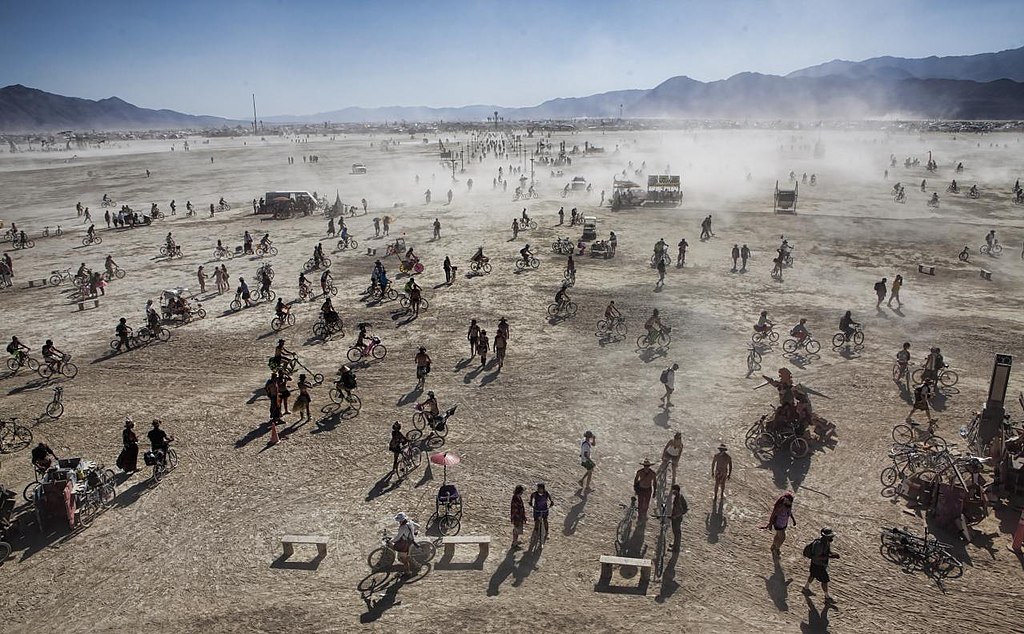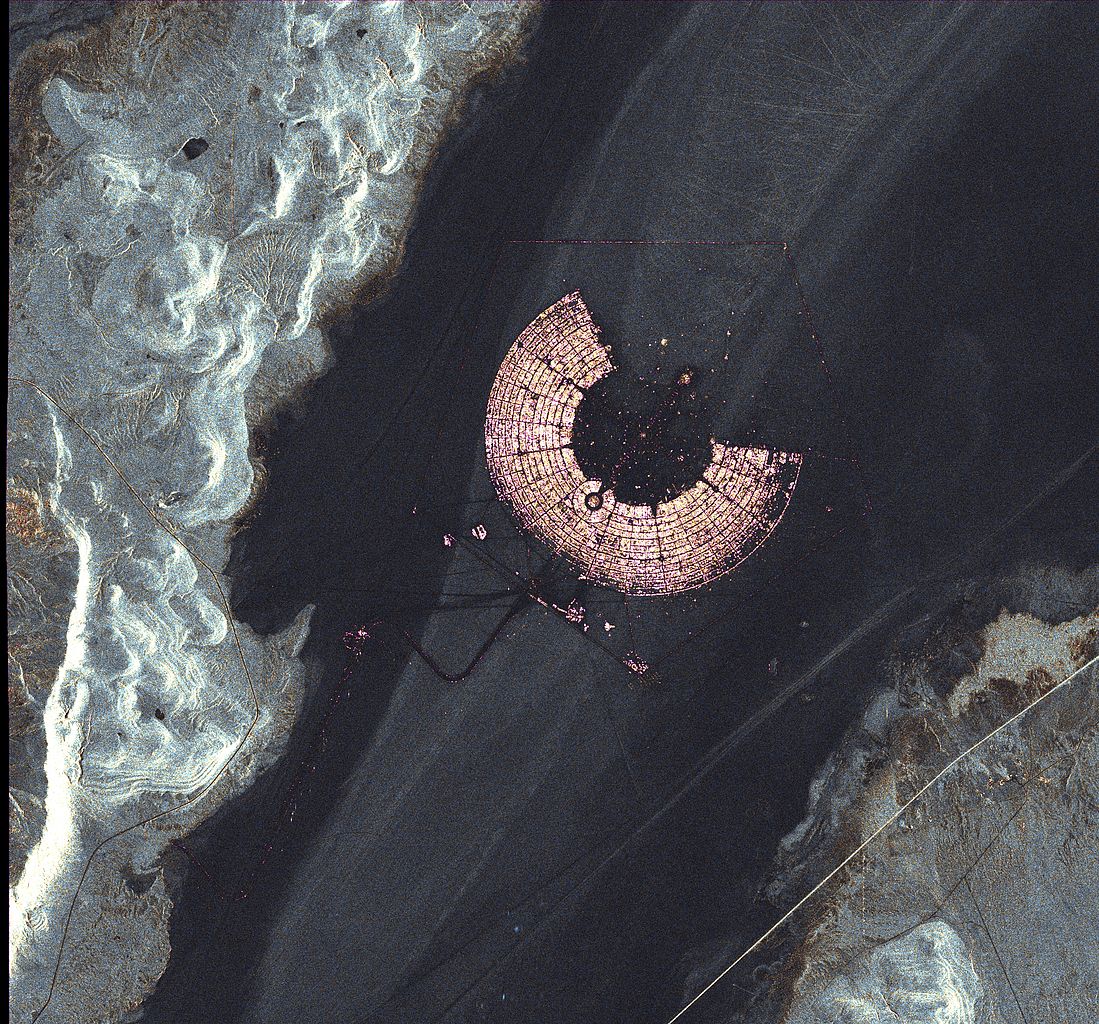Burning Man, which takes place annually in Black Rock Nevada, has become internationally renowned for its artistic beauty, infectious energy, and sense of camaraderie — yet it comes with a significant environmental expense: a massive carbon footprint that seems to go against the idea of what this festival is, in spirit, all about.

This image was originally posted to Flickr and was reviewed on 19 January 2016 by FlickreviewR and was confirmed to be licensed under the terms of the cc-by-2.0. Burning Man. (2023, September 12). In Wikipedia. https://en.wikipedia.org/wiki/Burning_Man
The event reports its carbon footprint to be 100,000 tons of carbon dioxide, more than 90 percent of which is accounted for by travel to and from the site. With tens and thousands of attendees sent to this remote desert location every year from around the world, there is an obvious uptick in associated polluting transportation emissions to and from the event and a variety of waste produced by these individuals who burn heavily constructed art pieces at the end of each season. Since the Burning Man festival is a signature event for many techno elites, there is no doubt the carbon emissions of private jets, which must be considered as well.
Let's face it. This year's Burning Man 2023 festival was a particularly muddy mess and didn't sound fun at all - for the land that hosted it or the people that frolicked there.
This no doubt exacerbated challenges to sustainable efforts. Cars found themselves trapped in muddy terrain, spinning tires, and burning fuel. Heck, celebrities like Chris Rock were left to rely on hitchhiking as an escape route from the Burning Man festival. Thankfully for Chris Rock, Will Smith didn't attend.
Truth be told, I have no idea if Will Smith attended or not. But, if he did, maybe instead of slapping Chris Rock, he would slap some of the people who didn't live up to Burning Man's "Leave no trace behind" principle.
People are indeed failable and the road to sustainability hell is paved with the best intentions.
This year's problems were not entirely the fault of the event itself. Extreme weather wrought by climate change is credited for increasing amounts of rain being dumped on the southwestern US states at this time of year. This had the effect of rendering the 2023 event a mudhole.
Sadly, Burning Man, this year, became a sign of the climate change times. Moreover, the sanitary conditions were far from ideal, with thousands of individuals confined to their shelters and compelled to share the use of limited restroom facilities.
Trevor Hughes, in an article appearing on the Reno Gazette Journal website, writes "...while attendees always leave trash and other detritus behind at what is touted as the world's largest Leave No Trace event, longtime Burners say this year appears to be the worst in memory, down to the toilet paper squished into the muck outside portable toilets and the soiled plastic bags people taped to their legs."
"While some of that trash and cars were abandoned within the Burning Man site, torn-open garbage bags and other trash litter the side of the road most people take to get home. About 73,000 people attended this year's event," Trevor Hughes writes.
Yikes! How much fun can you have when one must resort to a Home Depot orange bucket for a makeshift Port-A-John? But, I digress.
Make no mistake about it: there is still something cool about the idea of the Burning Man, which I believe sets up this event as a potential catalyst for sustainability.
The Burning Man festival retains an undeniable allure, captivating attendees with its unique celebration of art, self-expression, and community. The festival's vast expanse becomes a canvas for artists to create monumental installations that captivate the imagination and provoke thoughtful conversations. These are the types of open-minded folks in my opinion, who typically like helping our planet.
The principle of 'radical self-reliance' fosters a spirit of resilience and adaptation, while the ethos of 'gifting' nurtures a sense of generosity and camaraderie among participants.
Moreover, the 'burn' symbolizes a cathartic release, a chance to shed past burdens and embrace new beginnings.
So the potential is there for Burning Man can transform into an epic gathering of sustainability principles. It begs the question: How could you have all that is great about this festival and transform it into a "Leave No Carbon Footprint Behind" reality? Sound impossible? We don't think so and neither do the folks that run Burning Man. Yes, they have a plan.
Burning Man 10-Year Sustainability Road Map
The Burning Man Project's 10-Year Sustainability Roadmap aims to transform the annual Burning Man event into a NetZero sustainable event.
That, my friends, is quite an undertaking. Their roadmap outlines three goals for 2030 to make this happen:
- Handle Waste Ecologically. This means reducing the amount of waste produced at Burning Man and finding ways to recycle or compost it. How are they going to do this? Burning Man Project is working to reduce the amount of waste produced at the event by promoting recycling and composting. In fact, consider that in 2022, 90% of the waste produced at Burning Man was recycled or composted. That is quite impressive. Moreover, the Burning Man Project is working to develop new ways to reduce waste, such as using non-toxic materials and designing art that can be easily disassembled and recycled.
- Be Regenerative. We are not talking about generative AI content here, folks. What this means is taking steps to improve the environment around Burning Man, such as planting trees, restoring native plants, and reducing erosion. How is Burning Man faring so far? In 2022, the Burning Man Project planted over 10,000 trees and shrubs. The organization is also working to develop a plan to restore the Playa ecosystem after Burning Man ends.
- Be Carbon-Negative. Hey, in this case, a negative is a positive, right? This means offsetting all of the carbon emissions produced by Burning Man by investing in renewable energy projects and other carbon offset programs. We like to think they are off to a great start because, in 2022, the Burning Man Project reported offsetting over 100,000 metric tons of carbon dioxide.
It doesn't end there. The roadmap also includes a number of specific actions, for which the Burning Man Project has already lit the match. These actions include:
- Measuring and reducing greenhouse gas emissions.
- Increasing the use of renewable energy.
- Reducing the use of single-use plastics.
- Promoting water conservation.
- Educating participants about sustainability.
Driving sustainability is not a one-off burning art installation effort - and the folks at Burning Man know that!

Satellite image of Black Rock City taken from the TerraSAR-X satellite, 2011. DLR, CC-BY 3.0
The Burning Man Project is committed to continuing to work towards its sustainability goals. They describe their 10-Year Sustainability Roadmap as a "living document" that will be updated as new technologies and practices become available. Their goal is to make Burning Man a model for sustainable events around the world. So while there are plenty of sustainable issues to deal with they are taking them seriously and making headway.
Consider that in 2022, Burning Man was carbon neutral for the first time.
The 2022 event also reduced its waste production by 40% and increased its use of renewable energy by 50%.
The Burning Man Project is not only focusing on its famous annual event that takes place in the Black Rock Desert, but they are also expanding beyond the event and has purchased a property in Nevada to develop into a year-round cultural attraction to test and develop new sustainable technologies and practices. The property is the aptly named Fly Ranch because (I hate to date myself here) it is fly.
Fly Ranch: A Sustainability Community Incubator

Fly Geyser. In VistRenoTahoe.com. In https://www.visitrenotahoe.com/wp-content/uploads/2017/06/Fly_geyser-1024x773.jpg
Fly Ranch stands as an impressive and ambitious sustainable project as you will find.
Consider it comprises a 3,800-acre property in Northern Nevada, United States, about 20 miles north of Gerlach, Nevada. Purchased in 2016, Fly Ranch is owned by the Burning Man Project, the non-profit organization that produces the Burning Man festival. This is a really cool land.
Fly Ranch is home to the Fly Geyser, a geothermal geyser that was created accidentally in the 1960s when a well was drilled for geothermal energy. The geyser is now a popular tourist destination. In addition to the Fly Geyser, Fly Ranch is also home to a variety of other natural features, including wetlands, meadows, and mountains. The ranch will be used to test and develop new sustainable technologies and practices, and to create a space for people to come together and explore their creativity.
The Burning Man Project plans to develop Fly Ranch into a sustainable, educational, and cultural hub that leverages the values of the Burning Man event. The Fly Ranch project will include the development of educational programs, infrastructure for new creative works, artistic residencies, and research centers focused on renewable energy, water conservation, and other related topics. The project is still in its early stages, but some of the ideas that have been proposed include:
- A sustainable agricultural community
- A center for research and development in renewable energy
- A space for artistic and cultural expression
- A place for people to connect with nature and each other
Will the Burning Man Project one day move the Burning Man event to Fly Ranch? Good question. Burning Man Project has not yet announced any specific plans for its Burning Man to be held on Fly Ranch. However, the organization has said that it is committed to making Burning Man a sustainable event, and Fly Ranch is seen as a potential way to achieve this goal.
In the meantime, Burning Man will remain a fixture in the Black Rock Desert and, yes, so too will all the carbon emissions (and for better or worse, the myriad of bacchanalian hedonistic nudist, eh, "meet-ups" let's call them) will certainly continue to leave their marks. Invariably, the rain will continue to fall, and undoubtedly, the carbon footprint will get muddy as the people roll on the ground. However, if all goes according to the Burning Man Project's sustainability roadmap, and Fly Ranch's commitment to developing sustainable technology and practices, we dare say that a future where, by 2030, the big carbon footprint the event has today, will have all but disappeared like a flaming art installation vanishing in a star-filled desert night sky.
Now, then who took the Home Depot poop bucket?
Maverick Recommends
- Burning Man Project: 2030 Environmental Sustainability Roadmap
- FLY GEYSER – ONE OF NEVADA’S LITTLE SURPRISES
- Chaos and Climate Protests: Burning Man’s 2023 Rollercoaster
- Burning Man breakdown: How much pollution is the festival emitting?
- Can Burning Man Pull Out of Its Climate Death Spiral
- Visit Reno Tahoe
About Maverick
Maverick is the "call sign" of Mobile Gnosis publisher and managing editor, Matt De Reno.
Are you passionate about sustainable mobility?
Do you have insights or stories to share about how we can make our transportation systems more environmentally friendly, equitable, and accessible? If so, we want to hear from you! We are looking for contributors to our Sustainable Mobility blog.


